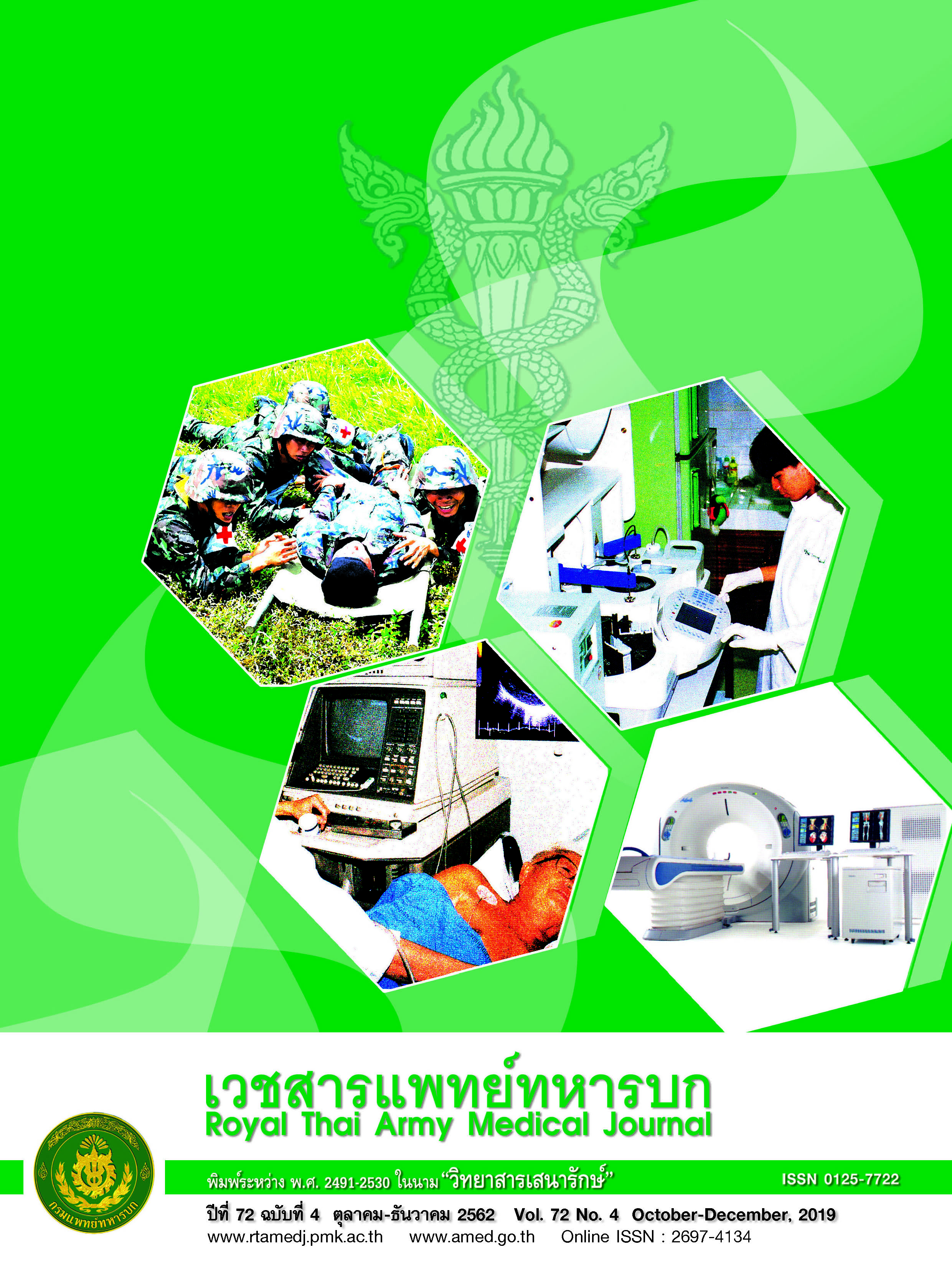ความชุกและปัจจัยที่เกี่ยวข้องของอาการผิดปรกติของกล้ามเนื้อและกระดูกโครงร่างในอาชีพนายหน้าซื้อขายหลักทรัพย์ กรุงเทพมหานคร
Main Article Content
บทคัดย่อ
ความเป็นมา อาชีพนายหน้าซื้อขายหลักทรัพย์ทำงานหน้าจอคอมพิวเตอร์เป็นเวลานาน ทำให้มีอาการปวดเมื่อยกล้ามเนื้อและกระดูกโครงร่าง จึงเป็นที่น่าสนใจในการศึกษาความชุกและปัจจัยของอาการปวดเมื่อยกล้ามเนื้อและกระดูกโครงร่าง เพื่อออกแบบการทำงานที่ป้องกันอาการปวดเมื่อยได้อย่างเฉพาะเจาะจง วัตถุประสงค์ เพื่อศึกษาความชุกและปัจจัยที่เกี่ยวข้องของอาการผิดปกติของกล้ามเนื้อและกระดูกโครงร่างในอาชีพนายหน้าซื้อขายหลักทรัพย์ กรุงเทพมหานคร วิธีการวิจัย เป็นการศึกษาเชิงพรรณนาแบบภาคตัดขวาง ณ จุดเวลาใดเวลาหนึ่ง (Cross-sectional descriptive study) กลุ่มตัวอย่างคือ นายหน้าซื้อขายหลักทรัพย์ 393 คน การรวบรวมข้อมูล ใช้เครื่องมือเป็นแบบสอบถามชนิดผู้ให้ ข้อมูลกรอกเอง (Self-reported questionnaire) ประกอบด้วย แบบสอบถามเกี่ยวกับ ปัจจัยด้านบุคคล (Non-occupational factors) ปัจจัยด้านการทำงาน (Occupational factors) ปัจจัยด้านท่าทางการทำงาน (Ergonomic factors) และแบบสอบถามเกี่ยวกับ อาการผิดปกติของระบบกล้ามเนื้อและกระดูกโครงร่าง ซึ่งดัดแปลงจาก แบบสอบถามนอร์ดิก (Nordic Musculoskeletal Questionnaire) และแบบสอบถาม the DASH score ผล ความชุกของอาการผิดปกติของระบบกล้ามเนื้อและกระดูกโครงร่าง ในกลุ่มตัวอย่างอาชีพนายหน้าซื้อขายหลักทรัพย์ ในช่วง 7 วัน ในช่วง 12 เดือน อาการกระทบต่อกิจวัตรประจำวันในช่วง 12 เดือน และต้องลาหยุดงานเนื่องจากอาการในช่วง 12 เดือนที่ผ่านมาคือ ร้อยละ 78.4, 82.2, 35.9 และ 20.4 ตามลำดับ อวัยวะที่มีความชุกสูงสุด คือ คอ ถัดมาคือ ไหล่ หลังส่วนบนและหลังส่วนล่าง การวิเคราะห์โดย Multiple logistic regression วิธี Backward LR ที่สัมพันธ์กับ Musculoskeletal disorder (MSD) ในช่วง 12 เดือน พบว่าผู้ที่มีโรคประจำตัวมีอาการ MSD เพิ่มเป็น 10.74 เท่า (p=0.022) โดยเป็นโรคภูมิแพ้มากที่สุด และผู้ที่นั่งเก้าอี้มีพนักพิงเพิ่มเป็น 4.54 เท่า (p<0.001) ปัจจัยป้องกันพบผู้ที่แก้ไขอาการปวดเมื่อยด้วยวิธีนวด/ประคบแผนไทยพบอาการ MSD ลดลงร้อยละ 50 (p=0.017) เมื่อเทียบกับผู้ที่ไม่ได้แก้ไขอาการปวดด้วยวิธีนี้ และผู้ที่ไม่มีการงอหรือกระดกข้อมือพบอาการ MSD ลดลงร้อยละ 52 (p=0.033) สรุป อาชีพนายหน้าซื้อขายหลักทรัพย์มีความชุกของอาการผิดปกติของระบบกล้ามเนื้อและกระดูกโครงร่างค่อนข้างสูง ควรให้ความสำคัญกับท่าทางการทำงานด้านการยศาสตร์ (Ergonomics) การส่งเสริมสุขภาพ (Health promotion) และป้องกันการเกิดโรค (Disease prevention)
Downloads
Article Details
บทความในวารสารนี้อยู่ภายใต้ลิขสิทธิ์ของ กรมแพทย์ทหารบก และเผยแพร่ภายใต้สัญญาอนุญาต Creative Commons Attribution-NonCommercial-NoDerivatives 4.0 International (CC BY-NC-ND 4.0)
ท่านสามารถอ่านและใช้งานเพื่อวัตถุประสงค์ทางการศึกษา และทางวิชาการ เช่น การสอน การวิจัย หรือการอ้างอิง โดยต้องให้เครดิตอย่างเหมาะสมแก่ผู้เขียนและวารสาร
ห้ามใช้หรือแก้ไขบทความโดยไม่ได้รับอนุญาต
ข้อความที่ปรากฏในบทความเป็นความคิดเห็นของผู้เขียนเท่านั้น
ผู้เขียนเป็นผู้รับผิดชอบต่อเนื้อหาและความถูกต้องของบทความของตนอย่างเต็มที่
การนำบทความไปเผยแพร่ซ้ำในรูปแบบสาธารณะอื่นใด ต้องได้รับอนุญาตจากวารสาร
เอกสารอ้างอิง
2. SET Thailand. Settrade your investment portal [Internet]. Bangkok: SET;2018 [cited 2018 Apr 28]. Available from: http://www.settrade.com/C00_Redirect.jsp?txtPage=products/th/broker.html
3. Angsuwotai P. WMSDs work-related musculoskeletal disorders. Hfocus [Internet]. 2013 [cited 2018 Apr 28] Available from : https://www.hfocus.org/content/2013/08/4213
4. Ergonomics assessment in Thailand. Standardized Nordic questionnaires for the analysis of musculoskeletal symptoms. [Internet]. 2014 [cited 2018 Apr 24]. Available from : http://thai-ergonomic-assessment.blogspot.com/2014/06/nordic.html
5. Rapipong J. Disabilities of the arm, shoulder and hand Thai translation [Internet]. 2006 [cited 2018 Apr 24]. Available from : http://www.dash.iwh.on.ca/sites/dash/public/translations/DASH_Thai.pdf
6. Ergonomics assessment in Thailand. Rapid office strain assessment (ROSA). [Internet]. 2014 [cited 2018 Apr 24]. Available from : http://thai-ergonomic-assessment.blogspot.com/2014/03/rapid-office-strain-assessment-rosa.html
7. Vinyoocharoenkul J, Pochana K. The Ergonomic risk assessment of computer user by rapid office strain assessment (ROSA) method. Journal of Public Health. 2015;45(2):148-158.
8. Sonne M, Villalta DL, Andrews DM. Development and evaluation of an office ergonomic risk checklist: ROSA--rapid office strain assessment. Appl Ergon. 2012;43(1):98-108.
9. Jaibarn P, Suthakorn W, Kaewthummanukul T. Ergonomic factors and work-related musculoskeletal disorders among hospital supporting staffs working with computers. Nursing Journal. 2013; 40(2):1-11.
10. Fischman ML. Building-Associated Illness. In: LaDou J, Harrison R, editor. Current occupational and environmental medicine. 5th ed. New York:McGraw-Hill Education;2014. p. 790-802.
11. World health organization regional office for the eastern Mediterranean. Health promotion and disease prevention through population-based interventions, including action to address social determinants and health inequity [internet]. [cited 2019 Jan 19]. Available from: http://www.emro.who.int/about-who/public-health-functions/health-promotion-disease-prevention.html
12. Ministerial regulations prescribing rules and procedures for health checks of employees and sending the results to the labor inspectors, 2004. Announced in the Government Gazette, Volume 122, Section 4 Kor, (2005 Jan 13):P. 19-22.
13. Department of Medical Service. Guidelines for health examination that are necessary and appropriate for the public. Bangkok: WVO officer of printing mill; 2016.


